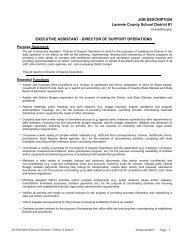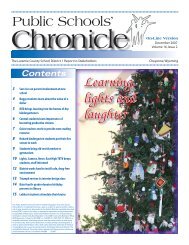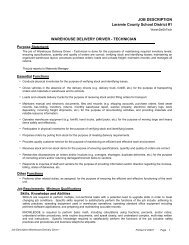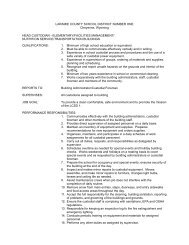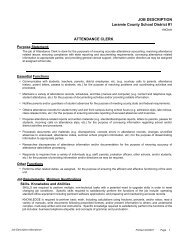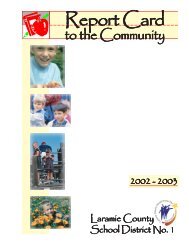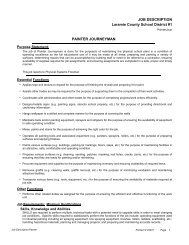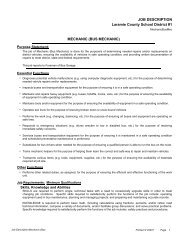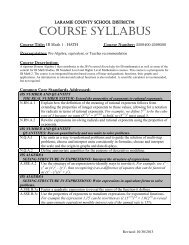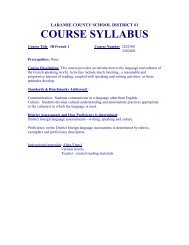10 • <strong>February</strong> <strong>2012</strong> Public <strong>School</strong>s’ ChronicleStudents connectArt &MusicJonathon Scott, a ninth-grade student from Central High <strong>School</strong>, interpreted Arturo Marquez’s Danzon No. 2 with this watercolor painting of atrumpet.“I interpreted Marquez’s piece DanzonNo. 2 by using a violin and working with watercolorand pastels. Watercolor has the abilityof capturing the layers, patterns and feelings ofthe melodies and harmonies of music. I wantedto highlight the tranquility but also contrast thetension of music. My watercolor is meant todemonstrate the different emotions of harmonyand pandemonium that music contains.”—Julia Dickie, 9 th Grade, Central High <strong>School</strong>(artwork is shown on this month’s cover)More than 250 artists’ statements,such as the one in the aboveparagraph, hung next to artworkon display at the Cheyenne Civic Center. Thepopular event center was empty, except for agroup of three judges who were busy evaluatingthe pieces. Lynn Newman, art coordinatorfor <strong>Laramie</strong> <strong>County</strong> <strong>School</strong> <strong>District</strong> 1, was onhand to lend his expertise and answer questionsas they arose.The group had devoted an entire aftern oonto evaluating student art entries for “Art inMusic,” an annual collaboration and celebrationof the arts between the Cheyenne SymphonyOrchestra and LCSD1.“This event has been a great fit for the communityand for us,” Newman commented.“We can’t expect the public to come into ourschools or in a classroom but they have a rightto know what we’re doing; so here’s a snapshot.”He explained “Art in Music” is the theme ofthe district’s quarterly art assessment. Studentsin all art classes between grades eight through12 are required to put together a demonstrationof their understanding of the conceptsthey’ve learned during the quarter using thistopic.“From our state and national standards, oneof the things we are asked to do is essentiallyconnect art with other disciplines,” Newmansaid. “So, in this case, we’re obviously connectingart and music and also dance.”While the overarching charge is to makethese connections, each teacher decides howthis will be done. For example, one teachermight use nature and ask students how aflower is like music. Students then show theirknowledge through their artwork and a writtenstatement describing their piece. Thus,Newman said students are graded on how wellthey demonstrate the concepts taught duringthe first semester through the art and accompanyingstatement.“The statement is really a clarity piece,”Newman said. “We’ve got to have that in placein order to really account for what the studenthas learned.”Newman said teachers who wish to participatein the art contest are encouraged toenter their students’ work. It is then judged bya panel of professional artists and a musician.First- through fourth-place awards are givenin every category from eighth- through 12thgradein both two-dimensional and three-dimensionalartwork categories. In addition, onepiece is selected as Best of Show and another ischosen as the Reserve Best of Show honor.Students were invited to attend the CheyenneSymphony Orchestra’s concert, titled“World of Dance,” Saturday, Jan. 28 to receiverecognition for their awards onstage. Duringbreak, student artwork received extra attentionas 1,500 concert goers milled throughout thelobby looking at the colorful creations.Newman said it’s fun to watch people look ata piece of art, read the statement and then lookat it again with a renewed understanding of itsmeaning. He explained this is extremely engagingfor students who hang out for the entireevent to see people’s reaction to their work.“How do we know the rigor is there?” Newmanasked. “It’s because we’ve aligned this tostate and national standards and we’re usingthe exact litmus test that professional artistsuse and the community is using when theylook at art. I don’t have to be an art historianto say, ‘oh, I have a better understanding ofhow this person is interpreting art,’ and in thatprocess people become engaged.”—Photo & text by Mary Quast
Public <strong>School</strong>s’ Chronicle <strong>February</strong> <strong>2012</strong> • 11Cole parents are partners in learningOver the past eight years, Cole Elementaryfamilies and staff have come togethermonthly for a night of delicious,homemade food, fellowship and an opportunityfor parents to learn more about how to supporttheir child’s learning at home.The event, which is called Partners in Learning,has become a highly anticipated schoolwidetradition, according to Title I teacherBrenda Ducharme, who has been coordinatorsince its inception.“The activities that we plan every monthsupport what is happening instructionally inthe classroom,” she said. “The goal of Partnersin Learning is to promote parents as their child’sfirst teacher so we work on activities where theparent is leading the learning.”Ducharme said she developed the programwhen she was asked to coordinate parent training.The evenings always begin with familiesenjoying a meal, which is homemade by teacherswho volunteer for the event.She said Principal Matt Schlagel designatesmoney from the school budget to pay for themeals and volunteers his time alongside teachers.“Education has changed so much over the lastfive years that it is critically important for us towork closely with our families to make sure theyhave the tools and program knowledge to helptheir children be successful in school,” Schlagelsaid. “Each month, anywhere from 40 to 100families meet in the gym to learn, explore newthings and have fun.”Elisa Beth Contreras and her son, Augi, enjoy reading a book togetherduring a recent “Partners in Learning” event at Cole Elementary.Ducharme said sheis always on the lookoutfor new themesthat tie to classroomlearning. She saidover the years, teachersand parents havebeen a good sourceof ideas.Schlagel explainedmany ideas are generatedfrom parentswho get together annuallyto develop theschool’s Title I ParentInvolvement Plan.He said: “It is fromthis group that thePartners in Learningtopics are developed.Our parent communitylets our teamknow exactly whatthey would like forus to focus on each month.”“We try to focus on reading, writing andmath for the most part, but we try to make itfun and hands on,” Ducharme explained.A particularly useful hands-on activityoccurred at the beginning of last school yearwhen Ducharme was able to work with <strong>Laramie</strong><strong>County</strong> <strong>School</strong> <strong>District</strong> 1’s warehouse toprocure desks that were formerly used in theold Rossman Elementary. She said warehouseworkers delivered about 100 desks to her at Colewhere she and her group of volunteer teacherscleaned and primed them.That month’s Partners in Learning wasthemed “Homework Habitat.” Following dinner,they led a quantum learning exercise withparents and students to reinforce the top 10study habits. Students then chose a desk to paintand take home so they had a place to do theirhomework.“Parents and kids loved that activity,” she said,“and it was something that hopefully continuesto support learning at home.”The learning has continued this school year.In September, parents previewed the school’sParent Resource Center, which contains acomputer, phone, resource library and learningactivity kits available for check-out.“We’re trying to build on the parent as theirchild’s first teacher by providing resources andmaterials for them to take home,” she said.Cole students John Banks, left, Kane Potter and Tra’Darius Luellan hang out while getting some reading doneduring the school’s January “Partners in Learning” event.November’s activity centered on MAP mathgames. A Thanksgiving-style dinner, partiallymade by students in the classroom, gave kids achance to use their math skills to triple recipeamounts and learn more about measurements.During December’s activity called “Turn up theHeat on Writing,” students read a holiday storyand incorporated dialog into their writing.In January, Ducharme was excited to offera LindaMood Bell language arts activity usingthe theme C.A.B.I.N. (create a book interestnight) Fever. Families gathered for beefstew, biscuits and s’mores before moving intothe “camp-out” activity where pajama-cladchildren sat with their parents on blankets andsleeping bags to hear more about reading andwriting. In addition, Cole’s Adopt-A-<strong>School</strong>partner, Goodwill, donated books so everychild left the event with a book in hand aswell as tips for parents to help their child withreading.“I enjoy seeing the kids interact with theirfamilies,” Ducharme said. “It’s awesome to seethem excited about learning and the familiesenjoying the time learning with their kids.”She added: “It’s in our school district’s missionthat we are a community of learners forlearners. Through this we are promoting ourdistrict’s mission.”—Photos & text by Mary Quast



